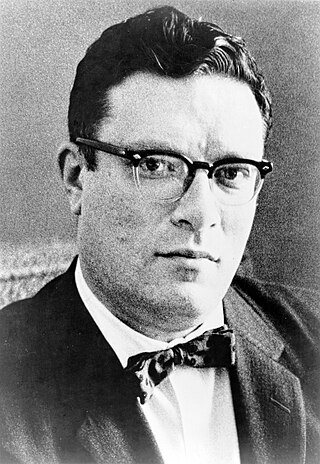
Isaac Asimov was an American writer and professor of biochemistry at Boston University. During his lifetime, Asimov was considered one of the "Big Three" science fiction writers, along with Robert A. Heinlein and Arthur C. Clarke. A prolific writer, he wrote or edited more than 500 books. He also wrote an estimated 90,000 letters and postcards. Best known for his hard science fiction, Asimov also wrote mysteries and fantasy, as well as popular science and other non-fiction.

Lyon Sprague de Camp was an American author of science fiction, fantasy and non-fiction literature. In a career spanning 60 years, he wrote over 100 books, both novels and works of non-fiction, including biographies of other fantasy authors. He was a major figure in science fiction in the 1930s and 1940s.
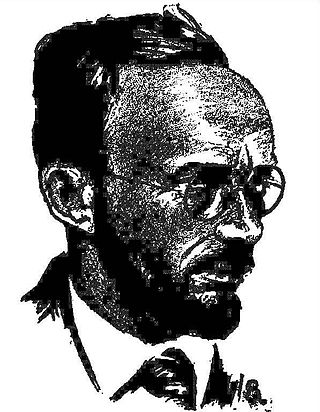
Murray Fletcher Pratt was an American writer of history, science fiction, and fantasy. He is best known for his works on naval history and the American Civil War and for fiction written with L. Sprague de Camp.
The Black Widowers is a fictional men-only dining club created by Isaac Asimov for a series of sixty-six mystery stories that he started writing in 1971. Most of the stories were first published in Ellery Queen's Mystery Magazine, though a few first appeared in Fantasy & Science Fiction, Isaac Asimov's Science Fiction Magazine, and the various book collections into which the stories were eventually gathered.
George H. Scithers was an American science fiction fan, author and editor.

John Drury Clark, Ph.D. was an American rocket fuel developer, chemist, and science fiction writer. He was instrumental in the revival of interest in Robert E. Howard's Conan stories and influenced the writing careers of L. Sprague de Camp, Fletcher Pratt, and other authors.
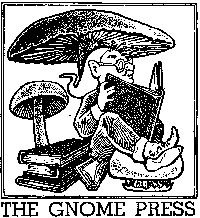
Gnome Press was an American small-press publishing company active 1948 – 1962 and primarily known for fantasy and science fiction, many later regarded as classics.

The Dragon of the Ishtar Gate is a historical novel by American writer L. Sprague de Camp, first published in hardcover by Doubleday in 1961, and in paperback by Lancer Books in 1968. The first trade paperback edition was issued by The Donning Company in 1982. The book was reissued with a new introduction by Harry Turtledove as a trade paperback and ebook by Phoenix Pick in September 2013. It has also been translated into German. It is the third of de Camp's historical novels in order of writing, and earliest chronologically. It is set in 466-465 BCE, the last years of the reign of King Xerxes I of Persia.
Donald Roynald Bensen, known also as Don Bensen and listed sometimes as D.R. Bensen, was an American editor and science fiction writer. As an editor he is known best for editing works of P. G. Wodehouse and his involvement with their re-issue as paperbacks in the United States. As an author, he is known best for his 1978 humorous alternate history novel, And Having Writ..., published first by Bobbs-Merrill company.

Footprints on Sand: a Literary Sampler is a 1981 collection of writings by science fiction authors L. Sprague de Camp and Catherine Crook de Camp, illustrated by C. H. Burnett, published by Advent. The collection was compiled to celebrate the de Camps' appearance as joint Guests of Honor at the June 12–14, 1981 X-Con science fiction convention in Milwaukee, Wisconsin and was limited to 1000 copies. An ebook edition was issued by ReAnimus Press in February 2021.
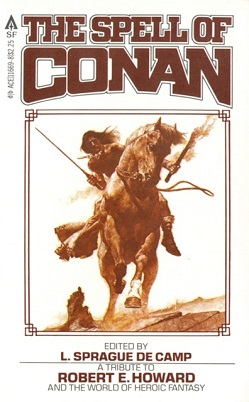
The Spell of Conan is a 1980 collection of essays, poems and fiction edited by L. Sprague de Camp, published in paperback by Ace Books. The material was originally published as articles in George H. Scithers' fanzine Amra. The book is a companion to Ace's earlier volume of material from Amra, The Blade of Conan (1979). Most of the material in the two volumes, together with some additional material, was reprinted from three previous books issued in hardcover by Mirage Press; de Camp's collection The Conan Reader (1968), and the de Camp and Scithers-edited anthologies The Conan Swordbook (1969). and The Conan Grimoire (1972).
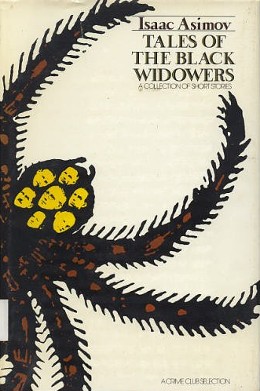
Tales of the Black Widowers is a collection of mystery short stories by American author Isaac Asimov, featuring his fictional club of mystery solvers, the Black Widowers. It was first published in hardcover by Doubleday in June 1974, and in paperback by the Fawcett Crest imprint of Ballantine Books in August 1976. The first British edition was issued by Panther in 1976. The book has also been translated into German and French.

Banquets of the Black Widowers is a collection of mystery short stories by American writer Isaac Asimov featuring his fictional club of mystery solvers, the Black Widowers. It was first published in hardcover by Doubleday in September 1984, and in paperback by the Fawcett Crest imprint of Ballantine Books in June 1986. The first British edition was issued by Grafton in August 1986.

Casebook of the Black Widowers is a collection of mystery short stories by American author Isaac Asimov, featuring his fictional club of mystery solvers, the Black Widowers. It was first published in hardcover by Doubleday in January 1980 and in paperback by the Fawcett Crest imprint of Ballantine Books in March 1981.

More Tales of the Black Widowers is a collection of mystery short stories by American author Isaac Asimov, featuring his fictional club of mystery solvers, the Black Widowers. It was first published in hardcover by Doubleday in October 1976, and in paperback by the Fawcett Crest imprint of Ballantine Books in November 1977. The first British edition was issued by Gollancz in April 1977.
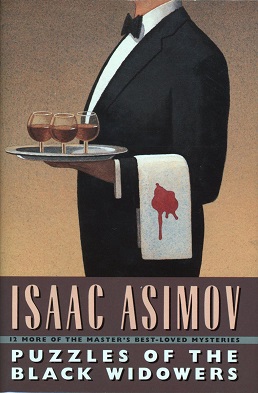
Puzzles of the Black Widowers is a collection of mystery short stories by American author Isaac Asimov, featuring his fictional club of mystery solvers, the Black Widowers. It was first published in hardcover by Doubleday in January 1990, and in paperback by Bantam Books the same year. The first British edition was issued in hardcover by Doubleday (UK) in April 1990, and the first British paperback edition by Bantam UK in April 1991.

The Return of the Black Widowers is a collection of short mystery stories by American writer Isaac Asimov, featuring his fictional club of mystery solvers, the Black Widowers. It was first published in hardcover by Carroll & Graf in December 2003, and in trade paperback by the same publisher in November 2005.

Inga Marie Pratt Clark was an American artist and book illustrator, who, with her husband Fletcher Pratt, was at the center of a circle of New York literary figures during the 20th century.
"Ph as in Phony" is a mystery short story by American writer Isaac Asimov. It was first published in the July 1972 issue of Ellery Queen's Mystery Magazine under the title The Phony Ph.D. The reason for this title change was that the magazine ran a series by Lawrence Treat with similar "_ is for _" titles. When it was republished in Tales of the Black Widowers in 1974, the original title was restored. It is the second published story about the Black Widowers, a gentlemen's club that solves mysteries based loosely upon the Trap Door Spiders, a stag-club of which Asimov was a member. It was reprinted in the collection The Return of the Black Widowers in 2003.

Tales from the Spaceport Bar is an anthology of science fiction club tales edited by George H. Scithers and Darrell Schweitzer. It was first published in paperback by Avon Books in January 1987. The first British edition was issued in paperback by New English Library in 1988.














